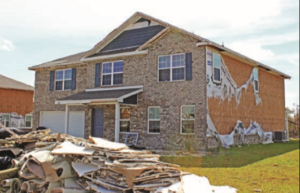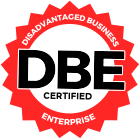Weaknesses noted in building code & mitigation measures

House with typical envelope damage (roof covering, siding, soffit, and fascia cover) observed on newer buildings after Hurricane Michael in the Panama City area, from FEMA’s Best Practices for Minimizing Wind and Water Infiltration Damage
Is Florida’s building code protecting all of us? That’s what we asked in two recent episodes of The Florida Insurance Roundup podcast. “It’s not that we expect to have no damage when we have a Category 5 hurricane, but we would like to not have catastrophic damage. We would like to not have loss of life. We would like the homes to still be livable. And with regard to Hurricane Michael and up in the Panhandle, we failed on all three of those fronts,” answered Cindy Shaw, a Senior Engineer and Southeast Regional Manager for Haag Engineering Services, a global forensic engineering and consulting firm.
Noted South Florida television meteorologist Bryan Norcross agreed, noting that although we have one state building code, it has different wind standards depending on where you live. “We have this high-velocity wind zone here in Southeast Florida, for no rational reason does it stop at the Broward County lines. There’s just no meteorological reason why you couldn’t have a Category 5 hurricane strike any part of the state of Florida and have a Category 3 or 4 hurricane go all the way across the state. Ironically, the Panhandle is especially vulnerable to strong hurricanes,” he said.

Cindy Shaw, Senior Engineer and Southeast Regional Manager, Haag Engineering Services

Bryan Norcross, Hurricane Specialist, WPLG-TV Local 10 News
As for the higher cost of construction that comes with a stronger code, Norcross and Shaw agreed that there are other places in the building where cost savings could be achieved and channeled to build a safer, more durable house. “It’s just too easy to do it all the way right, than to do it halfway,” said Shaw.
Our podcast discussion was based on a University of Florida engineering school report that found the building code for even the most recently built homes in the Panhandle wasn’t tough enough to withstand Hurricane Michael’s Cat-5 winds of 160 mph, featured in this recent newsletter story. You can listen to or read the podcast summary here. The House Business and Professions Subcommittee recently received a briefing on the UF report.

Charlie Clary, Founding Principal, DAG Architects
A few weeks later, we were honored to have join us a former state senator who had a hand in creating the state building code and the Panhandle’s wind standards. In the podcast Why the Panhandle Wasn’t Hurricane Strong for Michael, former Senator Charlie Clary explained that as part of making the codes tougher and more uniform throughout the state, policymakers wanted it to still be somewhat affordable as they built new homes, because of the very intense building growth at that time. “We have to just learn lessons from Michael and make the changes necessary,” said Clary, an architect.

Dr. Arn Womble, Research Engineer, Insurance Institute for Business & Home Safety
This newsworthy podcast was based on two recent FEMA post-hurricane assessments showing how mitigation measures failed in Panhandle construction, as featured in this recent newsletter story.
Also joining us was Dr. Arn Womble, with the Insurance Institute for Business & Home Safety, who expressed the frustration felt by many that roofing shingles don’t perform as well in real life as they do in the lab tests. “Roofing products themselves need improvement…and siding products haven’t gotten as much attention as roofing, but need to going forward,” he said.

Dr. Karthik Ramanathan, Assistant Vice President & Principal Engineer, AIR Worldwide
Dr. Karthik Ramanathan, with AIR Worldwide, said he’s seen improper installation of metal roofs in both Hurricanes Michael and Irma. “Time and again, you saw metal roofs installed on pre-existing shingle roofs. There seems to be a lack of knowledge and a need for education in proper installation,” he said.
We are told that the Florida Building Commission has taken note. It’s taking several steps with the support of the homebuilders to strengthen the next 7th Edition of the Florida Building Code to be published in December 2020. It includes adoption of ASCE 7-16, the newest Minimum Design Loads and Associated Criteria. While there’s no reported plans to change the various wind standards around Florida, the method for determining the design pressures on roofs for buildings less than 60 feet in height has changed. There are expected to be requirements for secondary roof underlayment to prevent water intrusion in the event the roof covering is blown off. This is for new construction as this standard has been around over 10 years for reroofing work. New sections are also being added to the code detailing requirements for the attachment of vinyl, fiber-cement, and hardboard. Wood structural panels and soffit panels are also being added to the code. All these moves were applauded by the podcast’s guests.
LMA Newsletter of 9/23/19


